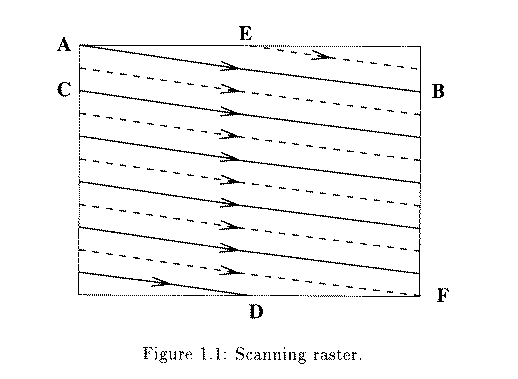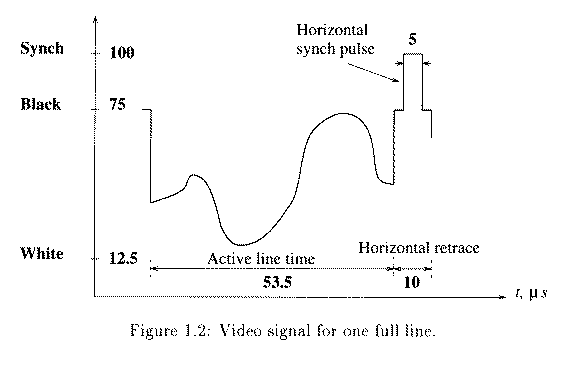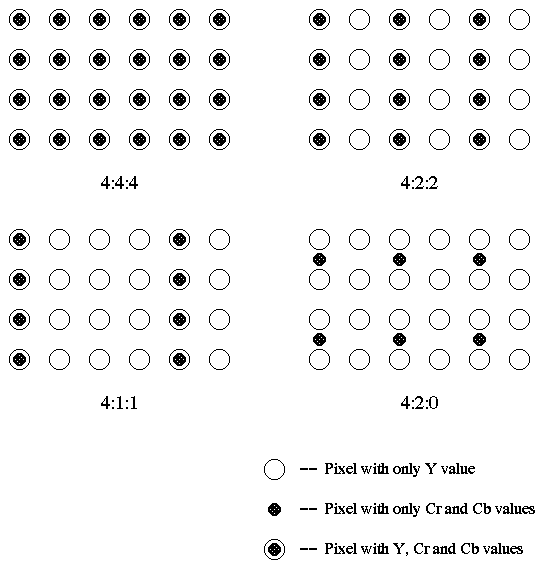Basics of Video
-
Analog video is represented as a continuous (time varying) signal.
-
Digital video is represented as a sequence of digital images.
Types of Color Video Signals
-
Component video -- each primary is sent as a separate video signal.
-
The primaries can either be RGB or a luminance-chrominance transformation
of them (e.g., YIQ, YUV).
-
Best color reproduction
-
Requires more bandwidth and good synchronization of the three components
-
Composite video -- color (chrominance) and luminance signals are
mixed into a single carrier wave. Some interference between the two signals
is inevitable.
-
S-Video (Separated video, e.g., in S-VHS) -- a compromise between
component analog video and the composite video. It uses two lines, one
for luminance and another for composite chrominance signal.
Analog Video
The following figures are from A.M. Tekalp, "Digital video processing",
Prentice Hall PTR, 1995, NTSC.


NTSC Video
-
525 scan lines per frame, 30 frames per second (or be exact, 29.97 fps,
33.37 msec/frame)
-
Interlaced, each frame is divided into 2 fields, 262.5 lines/field
-
20 lines reserved for control information at the beginning of each field
-
So a maximum of 485 lines of visible data
-
Laserdisc and S-VHS have actual resolution of ~420 lines
-
Ordinary TV -- ~320 lines
-
Each line takes 63.5 microseconds to scan. Horizontal retrace takes 10
microseconds (with 5 microseconds horizontal synch pulse embedded), so
the active line time is 53.5 microseconds.

Digital Video Rasters
-
Color representation:
-
NTSC uses YIQ color model.
-
composite = Y + I cos(Fsc t) + Q sin(Fsc t), where Fsc is
the frequency of color subcarrier
PAL Video
-
625 scan lines per frame, 25 frames per second (40 msec/frame)
-
Interlaced, each frame is divided into 2 fields, 312.5 lines/field
-
Uses YUV color model
Digital Video
-
Advantages:
-
Direct random access --> good for nonlinear video editing
-
No problem for repeated recording
-
No need for blanking and sync pulse
-
Almost all digital video uses component video
Chroma Subsampling
-
How to decimate for chrominance?

-
4:4:4 --> No chroma subsampling, each pixel has Y, Cr and Cb values.
4:2:2 --> Horizontally subsample Cr, Cb signals by a factor of 2.
4:1:1 --> Horizontally subsampled by a factor of 4.
4:2:0 --> Subsampled in both the horizontal and vertical dimensions
by a factor of 2. Theoretically, the chroma pixel is positioned between
the rows and columns as shown in the figure.
-
4:1:1 and 4:2:0 are mostly used in JPEG and MPEG (see Chapter 4).
CCIR Standards for Digital Video
(CCIR -- Consultative Committee for International Radio)
CCIR 601 CCIR 601 CIF QCIF
525/60 625/50
NTSC PAL/SECAM
-------------------- ----------- ----------- ----------- -----------
Luminance resolution 720 x 485 720 x 576 352 x 288 176 x 144
Chrominance resolut. 360 x 485 360 x 576 176 x 144 88 x 72
Color Subsampling 4:2:2 4:2:2 4:2:0 4:2:0
Fields/sec 60 50 30 30
Interlacing Yes Yes No No
-
CCIR 601 uses interlaced scan, so each field only has half as much vertical
resolution (e.g., 243 lines in NTSC). The CCIR 601 (NTSC) data rate is
~165 Mbps.
-
CIF (Common Intermediate Format) -- an acceptable temporary standard
-
Approximately the VHS quality
-
Uses progressive (non-interlaced) scan
-
Uses NTSC frame rate, and half the active lines of PAL signals --> To play
on existing TVs, PAL systems need to do frame rate conversion, and NTSC
systems need to do line-number conversion.
-
QCIF -- Quarter-CIF
ATSC Digital Television Standard
(ATSC -- Advanced Television Systems Committee) The ATSC Digital Television
Standard was recommended to be adopted as the Advanced TV broadcasting
standard by the FCC Advisory Committee on Advanced Television Service on
November 28, 1995. It covers the standard for HDTV (High Definition
TV).
Video Format
The video scanning formats supported by the ATSC Digital Television
Standard are shown in the following table.
|
Vertical Lines
|
Horizontal Pixels
|
Aspect Ratio
|
Picture Rate
|
|
1080
|
1920
|
16:9
|
60I 30P 24P
|
|
720
|
1280
|
16:9
|
60P 30P 24P
|
|
480
|
704
|
16:9 & 4:3
|
60I 60P 30P 24P
|
|
480
|
640
|
4:3
|
60I 60P 30P 24P
|
-
The aspect ratio for HDTV is 16:9 as opposed to 4:3 in NTSC, PAL, and SECAM.
(A 33% increase in horizontal dimension.)
-
In the picture rate column, the "I" means interlaced scan, and the "P"
means progressive (non-interlaced) scan.
-
Both NTSC rates and integer rates are supported (i.e., 60.00, 59.94, 30.00,
29.97, 24.00, and 23.98).
-
At 1920 x 1080, 60I (which CBS and NBC have selected), there will be 1920
x 1080 x 30 = 62.2 millions pixels per second. Considering 4:2:2 chroma
subsampling, each pixel needs 16 bits to represent, the bit rate is 62.2
x 16 = 995 Mb/sec.
Homepage of the Advanced Television Systems
Committee (ATSC)
Top | Back to DV-NLE





